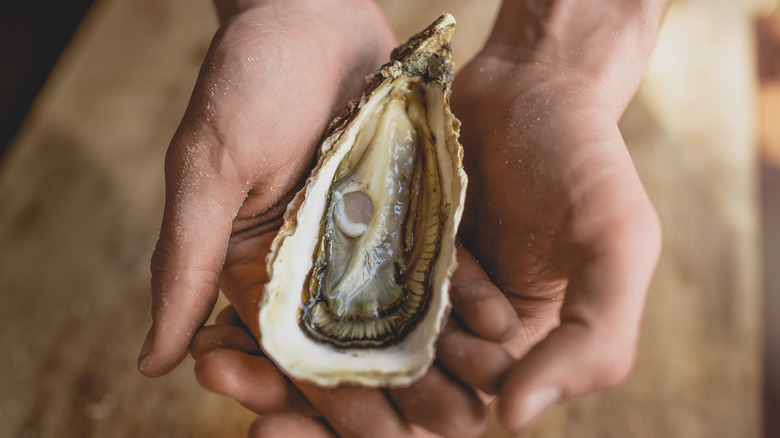The Real Reason You Should Stop Eating Raw Oysters
Oysters are delicacies that have foodies raving around the world. They also happen to be packed with important nutrients like selenium, zinc, iron, Vitamin B12, and Vitamin D (via The Cleveland Clinic). But although there is a long culinary tradition of eating them raw and "on the half" shell, consumers might want to think twice before devouring this tasty bivalve mollusk without cooking first. According to the CDC, eating raw oysters puts you at risk of infection from vibrio bacteria, which inhabit coastal waters and often build up in oysters, who act as filters in their underwater habitat.
While some types of vibrio bacteria simply make you nauseous or give you diarrhea, a specific species called vibrio vulnificus can actually cause severe damage to your body, such as blistering skin lesions and bloodstream infections, which sometimes result in the amputation of limbs or, in 15-30 percent of infections, death. Not quite worth a night of savory indulgence is it?
Even worse, oysters infected with vibrio bacteria often look, smell, and taste the same as fresh and uncontaminated oysters, meaning you probably won't know the difference as they go down. The good news is that vibrio bacteria, including the potentially deadly vibrio vulnificus, are heat sensitive, and simply cooking oysters for enough time is usually enough to rid them of this dangerous risk.
Safer ways to eat oysters
Recently, oyster producers and retailers have started using a variety of post harvest processing methods to reduce bacteria while retaining as much of the raw, uncooked taste as possible. These processes include freezing, low temperature pasteurization, irradiation, and high pressure processing, or HPP (via Food Protect). According to a 2014 study published in the scientific journal Foods, HPP not only kills off bacteria that infects oysters, including vibrio, but also rids them of viruses.
But according to the CDC, the safest course of action is to be proactive and have your oysters properly cooked. This way, you can preserve their unique texture and rich flavor while making sure that any bacterial contamination is eliminated to the point that you really don't have to worry about vibrio making its way into your system and sickening you. According to the Washington State Department of Health, you must heat the interior (meaty part) of a raw oyster to at least 145 degrees F for at least 15 seconds to kill off whatever live vibrio bacteria may be present. They also warn that from the time the shells open, this may take four to nine minutes if you are steaming them or three to five minutes if you are boiling them.


